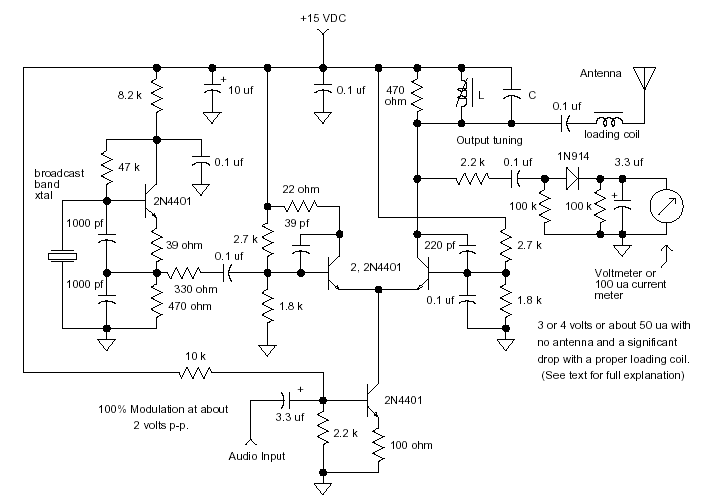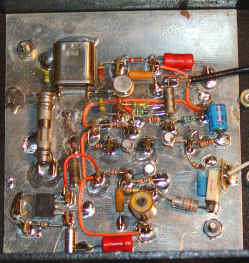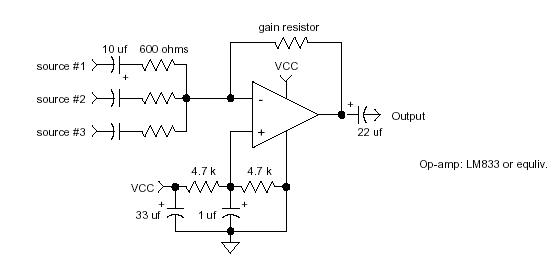On this post, I am going to show how to design an AM transmitter. AM transmitter is one of the simplest modulation system. Other simplest modulation system is CW (Continuous Wave). AM produced by adding information signal to carrier signal. This process is called wave superposition. Carrier signal is signal that carries information signal to another location. Carrier signal also called RF (Radio Frequency). RF spreads from lowest frequency of MF (Medium Frequency): 300KHz up to highest of Satellite Frequencies (around 15GHz).
Simple AM transmitter made of 2 stages. Preliminary stage consists of oscillator, and 2nd. stage consists of RF amplifier. You could add/design your own succeeding stages, thus improve output power and transmission distance.
When information signal is in form of directly added digital signal, this modulation is called ASK (Amplitude Shift Keying). This AM transmitter could also modulated by BPSK, QPSK and AFSK (Audio Frequency Shift Keying), but those signals of BPSK, QPSK, and AFSK should be formed first. On this research, I modulate carrier with analog signal only, so called "AM".
On this design, I have designed oscillator with Colpitts Oscillator system that has good frequency stability (fulfil certain criteria first). Class A RF amplifier stage built as voltage amplifier that tries to increase output AC voltage compared to input. Because transistor characteristic also increases current, this voltage amplifier also increases output power compared to input. Both oscillator and RF amplifier use common emitter configuration and NPN transistors. Output impedance of AF/RF Class A transistor amplifier with common emitter configuration is around 50,000 (50K) Ohms. Output impedance of any amplifiers could be downed using impedance transformer. Most of audio speaker have 8 Ohms impedance. In this case, needed 50,000 Ohms to 8 Ohms impedance transformer. Most of transmitter antenna have 50 Ohms impedance. In this case, needed impedance transformer that could change 50,000 Ohms into 50 Ohms. Output impedance of AF/RF PushPull Class B or Class AB transistor amplifier with common emitter configuration is around 100,000 (100K) Ohms. PushPull Class B transistor amplifier formed from 2 Class B transistor amplifiers put in parallel, output impedance forms series (50,000 + 50,000 Ohms). PushPull Class B or Class AB transistor amplifier works more efficient, because reduces existence of Collector Voltage, but works less linear compared to Class A. In Class A, there is Collector Voltage existence (consumes energy), but this Class A more linear compared to PushPull Class B or Class AB. Class AB PushPull amplifier is modification of Class B PushPull amplifier in order to reduce crossover distortion. So from side of linearity, Class A is best, Class AB PushPull is second, and Class B PushPull is third.
In order to design an oscillator or RF amplifier, you would need oscilloscope at least. There are various kinds of oscilloscope, eg. 5MHz oscilloscope could measure RF up to 5MHz accurately. 20MHz oscilloscope could measure RF up to 20MHz accurately. If oscilloscope used above specification, oscilloscope could still show current curve/graphic, but could not measure voltage or frequency accurately. Eg. if you like to design VHF FM transmitter with frequency around 90MHz, you would need at least 5MHz oscilloscope and frequency counter that could measure 90MHz. Oscilloscope needed especially to measure voltage amplification accurately.
RF amplifier voltage amplification (on this design): 0.5Vpp/2.3Vpp= 0.217 . Current-gain bandwidth product (fT) of 2SC2053 is not mentioned in 2SC2053 DataSheet. In DataSheet only mentioned that 2SC2053 is transistor for VHF RF Amplifier. That's why I didn't doubt to use this transistor. Transistor with VHF purpose could be used at HF and AF. Maximum frequency of VHF is 300MHz, so I assumed fT little beat higher than 300MHz. Assumed 2SC2053 fT=400MHz ---> ßrf=400/8.8=45.45 so power gain/amplification=0.217x45.45=9.86 .
This means if earlier stage produces z Watts, this RF amplifier would increase power to 9.86z Watts.RF amplifier principle is to amplify power from stage to stage. Succeeding stage should have more power compared to earlier. This principle could be used if you don't know fT of one transistor. Just estimate fT of that transistor, keep calculate, and after you've finished particular stage, just check its power. Its power should be more compared to earlier stage. If you are designing RF amplifier, you could check S (signal) meter at receiver that shows power strength of particular transmitter. If that stage fails to improve power, you should recalculate that amplifier. In my experiment, my receiver S meter showed increase signal when RF amplifier applied compared to "just" oscillator applied, means 2SC2053 fT=400MHz is good estimation, and this RF amplifier works to amplify oscillator power.Wherever you like to assemble this circuit (or any RF circuits): on breadboard or PCB, there should be "certain" distance between lines. Between lines could not be placed too closed, due to RF absorption.
I've tried to modulate this transmitter with song signal from small radio/tape player. This "analog signal" is added/joined with carrier signal at oscillator output (at this design at oscillator collector). Because this radio/tape player produces sufficient power, I do not need impedance transformer. I only add 1Kohm variable resistor to adjust modulation index. Good AM transmitter when modulation index=1. If modulation index more than 1 (too much information signal power added), this transmitter would suffered "over modulation", while if modulation index less than 1, this transmitter would be in "lack of modulation". Result: Good for HF AM class, although would not as good as VHF FM transmitter, because HF is full of static noise (QRN) from electric power and full of signal from all over World (QRM), while VHF is relatively clearer. One good thing about HF transmitter: it could travel very far without satellite help because this band signal is reflected by ionosphere, even many times I've communicated with places with distance around 20 thousands kilometers away from my location with small transmitter power only (used HF).
This transmitter also completed with "long wire" antenna put in high location with big diameter of wire. One end of long wire connected to antenna sign at schema. Although this transmitter not completed with antenna impedance matcher, but existence of any good antennas would help electromagnetic wave to spread better. When transmitter output impedance, transmission line characteristic impedance, and antenna input impedance are match, voltage & current at load (antenna) would be maximized, thus maximize power at antenna and transmission distance. If impedances are not match, there would be standing wave at transmission line, causes not all power dissipated at antenna, but portion of power dissipated at transmission line (reflected power), thus decreases antenna effectiveness.
Negative polarity of DC supply connected to ground sign.
RFCs I use are fabricated RFCs. One way to make 0.5349µH (tuning coil):

Under are schema of this design and photo of this circuit built at breadboard (if you are not clear with schema, just left click at that schema):

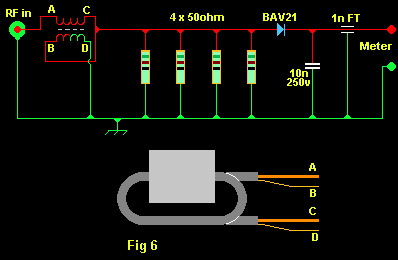
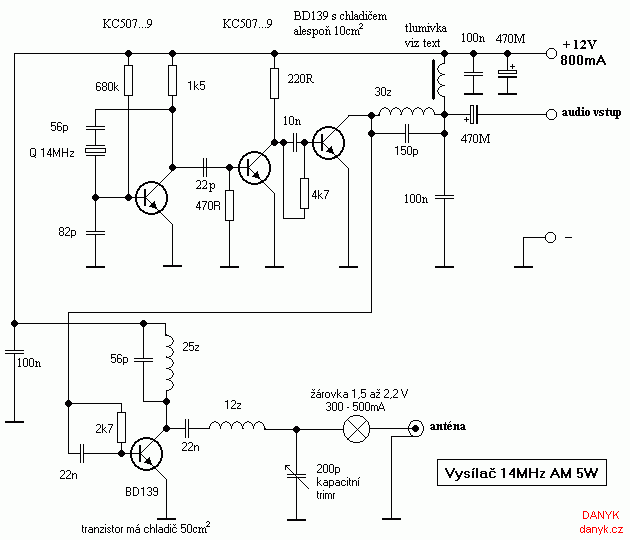
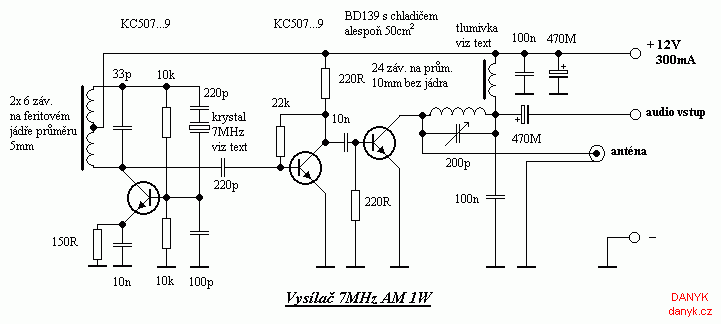








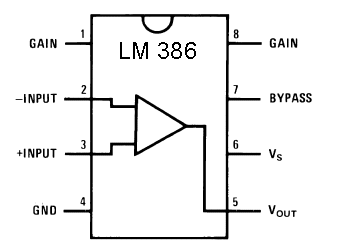
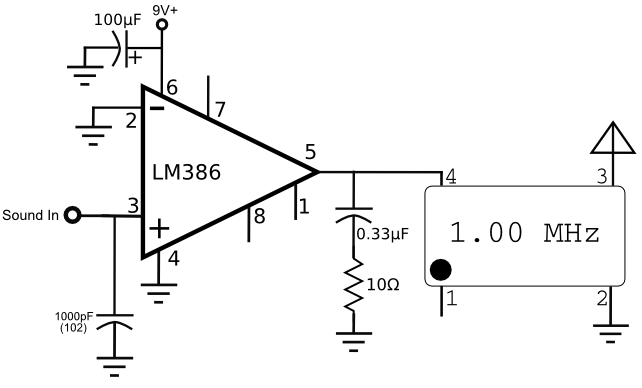

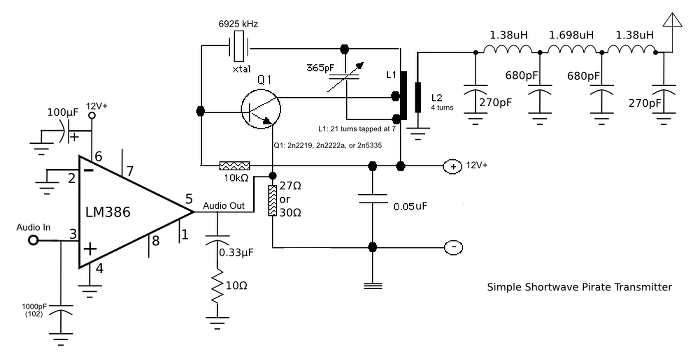
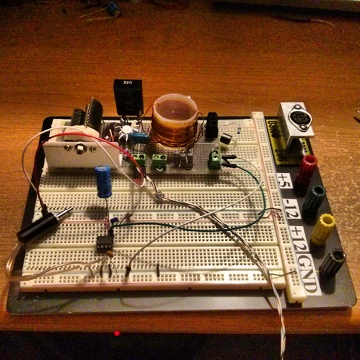






![[schematic diagram]](http://www.geocities.ws/raiu_harrison/mwa/tech/circuits/poppet.gif)


